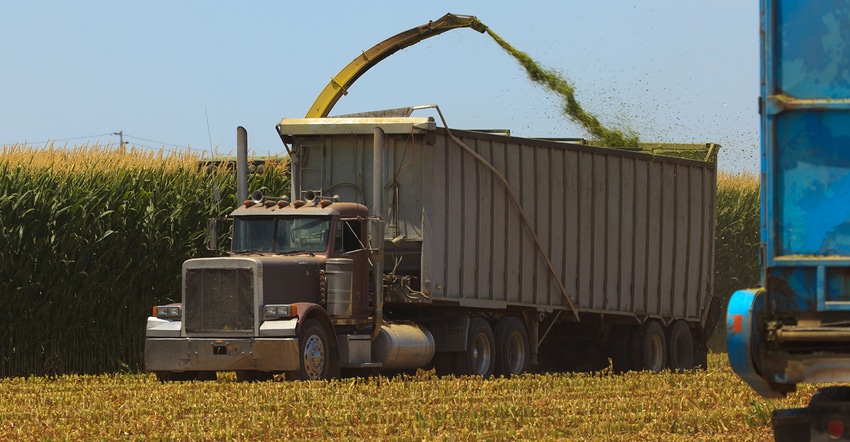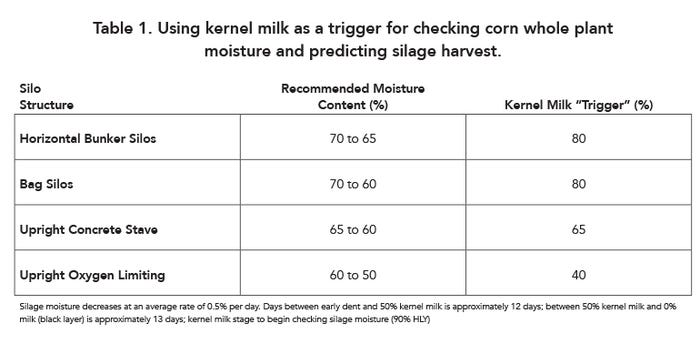September 1, 2021

Sponsored Content
Planting delays, poor ear formation, and lack of standability are just a few reasons why some farmers may want to consider taking their corn crop for silage. When making this decision, there are a few factors to keep in mind. These include how to optimize silage quality, tonnage, agronomics, and pricing of the crop.
Optimizing Silage Quality and Tonnage:
The “milk line” method is widely used to determine when a field should be harvested. The relative position of the milk line in the kernel is an indicator of the plant’s moisture content. For a more precise indicator, farmers must chop plants up (typically with a small brush chopper) and then dry down the sample with a microwave or Koster oven. Keep in mind that the ensiling storage technique will determine optimal harvest moisture.


QUALITY FACTORS:
Cutting Height: Corn silage cutting height and quality are directly proportional. At a cutting height of 18 in., tonnage will go down compared to a 6 in. cutting height by as much as 15%, but the resulting silage has increased in quality (milk/ton). Increasing your cutting height leaves more beneficial crop residue in the field with only a marginal decrease in pounds of milk/acre. If harvesting drought stressed corn, keep cutting height above 8 in. to avoid excess nitrates in the silage.
Crop Condition: Corn with foliar disease, poor crop condition, or other factors that may make grain harvest a challenge can also reduce silage quality. The cost of additional tonnage to make a ration, difficulty packing the silage, and a prolonged period to achieve stable ensiled conditions may outweigh the complications for the combine.
AGRONOMICS
Silage harvest typically begins earlier in the year and removes the entire above-ground portion of the plant from the field, so keep these things in mind:
Post-Harvest
Almost all crop residue will be taken. Remember to protect the soil from erosion.
Harvesting silage provides an excellent opportunity to put in a cover crop that will scavenge residual nutrients, prevent erosion, and build soil microbe populations.
Fertility
Silage removes roughly three times the amount of (K2O) potassium that a grain corn crop would remove. For example, a 200 Bu./A. grain corn crop removes 50 lb. K2 O in the grain while a 21-ton silage crop removes 153 lb. K2O.
Higher levels of secondary and micronutrients will also be removed.
Compaction
Because of the large number of pounds being removed, there will be more truck/machinery traffic.
Since harvest timeliness plays a role in the silage quality, harvest may occur when soil conditions are less than ideal, resulting in more compaction.
SILAGE PRICING
Unlike a grain corn crop which has many markets and straight-forward pricing structures, pricing silage requires farmers to look at a few more metrics (fertility, quality, grain price, etc.) to come up with a fair price for both the farmer and the buyer. Keep these points in mind when setting a price with a buyer:

Consider harvesting costs and the drying charges/shrink that you would have incurred had you harvested for grain.
Don’t forget about nutrient removal costs; the extra nutrients removed with silage need to be replaced.
If a silage-specific hybrid was grown to optimize quality, there needs to be a premium based on the nutritional qualities of the silage.
Interested in planting Beck’s corn silage products? Check out the ‘2021 Alfalfa and Silage Seed Guide’ under the ‘Product Guides’ here: https://www.beckshybrids.com/Multimedia-Literature/Literature. For more questions on managing and marketing silage, please reach out to your local Beck’s representative.
Beck’s is the largest family-owned retail seed company in the United States that serves farmers in Arkansas, Illinois, Indiana, Iowa, Kansas, Kentucky, Michigan, Minnesota, Mississippi, Missouri, Ohio, South Dakota, Tennessee, and Wisconsin. According to a recent seed industry survey, Beck’s ranks as the third largest corn and soybean brand in the United States. At their core, all Beck’s employees are Farmers at Heart. It stands for something special. It has soul. It has truth. And it represents a community of farmers, employees, and dealers who strive each day to seek challenges, push boundaries and innovate. Beck’s has, and always will be, proud to serve a community of farmers who love what they do and who are proud to be… Farmers at Heart. For more agronomic new and information, visit Beck’s Agronomy Talk page or blog at BecksHybrids.com.
You May Also Like




